At present, we are more blessed than at any other time in history as far as ammunition is concerned. The quality and consistency of ammunition have advanced massively over the past few decades, especially in defensive handgun ammo, which we’ll be looking at today in this article.
Defensive Handgun Ammo In the Spotlight
On April 11, 1986, several FBI agents attempted to arrest two violent felons in a vehicle stop in Miami, Florida. In the ensuing firefight, two agents were killed and five more wounded. Both felons were killed in the gun battle.
Although a multitude of factors were at play during this clash, the FBI decided to focus its blame on one 9mm bullet, claiming that it was to blame for not stopping one of the felons. A 9mm Winchester Silvertip bullet penetrated the felon’s chest but stopped just short of reaching the heart. It was a non-survivable wound, but as often happens, bad guys don’t know they’re supposed to fall down and die. And so this bad guy kept fighting until his body shut down.
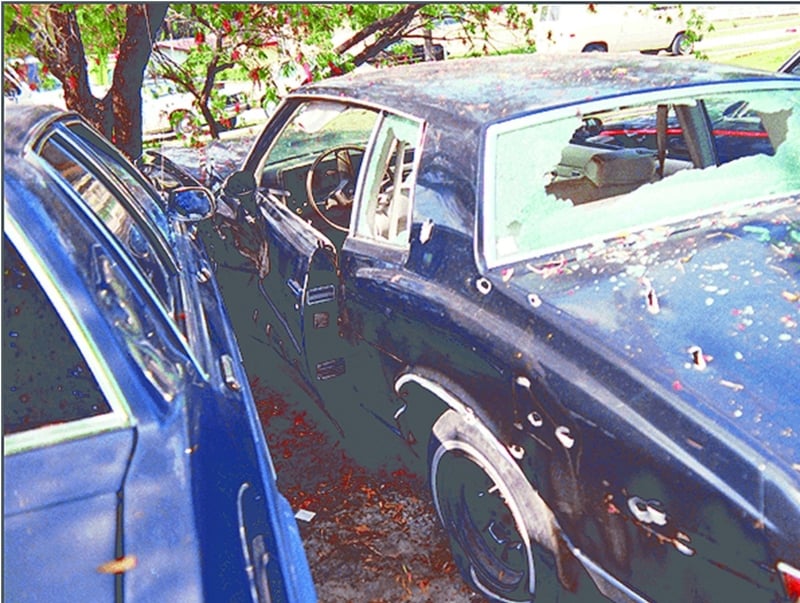
Had that bullet penetrated just a little farther, it would have hit the criminal’s heart and likely stopped his ability to fight in short order. The FBI became obsessed with bullet penetration as a result, deciding that agents needed a more powerful caliber for their defensive handgun ammo loads. Suddenly, the 9mm was persona non grata. They developed a list of requirements that are still in use today by the FBI and many nationwide departments.
Thus began the odyssey of the 10mm and later the .40 caliber rounds, adopted by the FBI, respectively.
FBI Protocol
The FBI lists several barriers that must be successfully penetrated. They are as follows:
- Bare 10% ballistic gelatin.
- Auto glass (one piece 15×18 inch ASI 1/4-inch-thick laminated safety glass set at a 45-degree angle.
- Sheet metal (two pieces of 20 gauge sheet steel, replicating auto body metal).
- Heavy clothing (Two layers of cotton t-shirt material, one layer of PolarTec Fleece, and one layer of cotton denim).
- Wallboard (two pieces of standard 1/2-inch gypsum spaced 3.5 inches apart).
- Plywood (one piece 3/4-inch thick).
Of course, these are individual tests and are not to be penetrated simultaneously. After penetrating these mediums, the bullets are required to penetrate the FBI’s requirement of 12-18 inches of 10% ballistic gelatin covered with simulated light clothing.
The FBI focuses on penetration, which is helped by the bullet holding together and retaining its weight. They found that bullets that penetrate more deeply reach vital organs and create blood loss, which stops bad guys.
To expect a bullet to penetrate that deeply in ballistic gelatin after traveling through the above barriers is a very demanding requisite. The fact that ammo companies can and do produce rounds capable of doing so is extraordinary!
In no particular order, let’s take a look at five favorable choices for defensive handgun ammo.
Hornady Critical Duty Defensive Ammo
Hornady’s Critical Duty is a 135-grain 9mm bullet. Hornady took a unique approach by including a FlexLock polymer ball in the nose of the bullet. They use the polymer ball to get around an issue that hollow point ammunition sometimes experiences, which is to plug up with the medium that it’s passing through and then act as a full metal jacket round.
In the Critical Duty ammo, the polymer ball is not compressible, forcing the projectile to open up instead of acting as an FMJ.
A jacket-to-core interlock band prevents the core of the bullet and the jacket from separating, helping the bullet retain weight and penetrate deeply enough into the target to be effective.
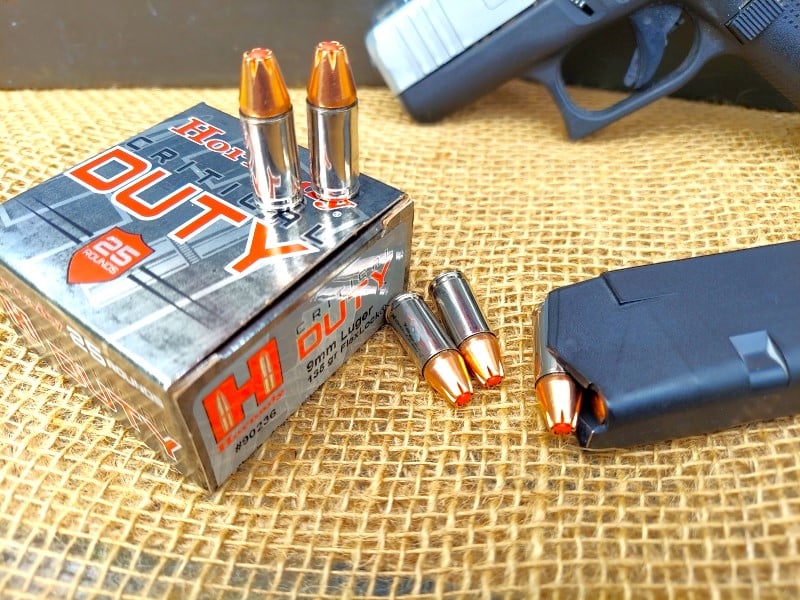
As mentioned, this is 135-grain ammo. Normally, 9mm ammunition comes in three flavors: 115, 124, and 147 grains. This one falls between the norm.
Other Features
Hornady uses nickel-plated cases for this defensive handgun ammo, which helps the rounds feed and extract more reliably. Nickel is also brighter in color than brass, so we can see the casing in the chamber more easily, especially in low light.
Another unique aspect of this ammunition is that it is technically not a hollow point (though it performs similarly). That becomes relevant in certain jurisdictions that limit the possession or use of hollow point ammo. Shooters can have a very effective bullet without falling askance of the law.
Hornady uses a low-flash powder with this defensive handgun ammo. The recoil was mild in the Glock 43X that we fired the rounds through. Accuracy was outstanding as well, with headshots at 15 yards being no problem. All in all, this ammo gets two thumbs up!
This line of ammo is available in a variety of calibers, including .223, .380ACP, 10mm, .30 Super Carry, .22 WMR, .40 S&W, .357 Magnum, .357 Sig, .45ACP, .308, .25ACP, and .30 Carbine.
Speer Gold Dot 124 Grain +P Handgun Ammo
Speer’s Gold Dot 124-Grain +P hollow point ammo is used by over 3,000 US and foreign agencies, including the FBI, Department of Homeland Security, US Customs and Border Protection, NYPD, California Highway Patrol, NJ State Police, PA State Police, and others.
This bullet meets the FBI’s stringent requirements, which is one of the reasons why it’s so popular and widely used.
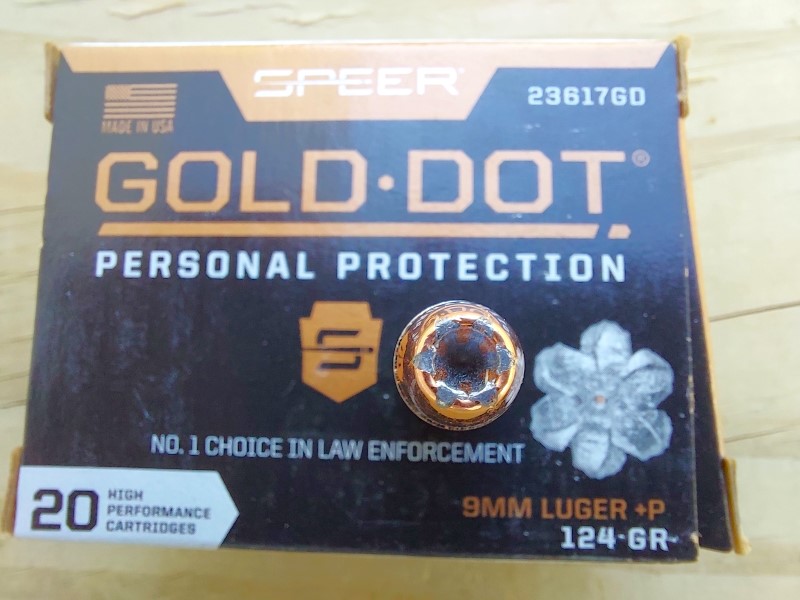
The Gold Dot has a structural-plated, pressure-formed core that’s part of its Uni-Cor bonding. This ensures the projectile holds together as one piece when traveling through obstacles and bad guys. As we’ve mentioned, bullets that hold together penetrate better, allowing the projectile to reach vital organs and shut the attacker down.
Although it’s rated as +P ammunition, these rounds don’t exhibit an increase in muzzle flash or recoil that I could discern at the range. I’ve used this ammo extensively over the decades in various calibers through a wide variety of handguns and never once experienced an issue with the ammo. That includes the Glock 43 and 43X, the Sig P226, P228, S&W CSX, Springfield’s Hellcat, and the S&W 642 revolver. I currently carry this load in several of my pistols and my .38 Special S&W 642.
Other calibers in the line include .40S&W, .380 ACP, .45ACP, .223, and others.
Federal Hydra-Shok Ammo
Federal’s Hydra-Shok was introduced in 1989 to address the new (at the time) FBI’s request for enhanced terminal ballistics that were prompted by the Miami shootout.
Hydra-Shok has undergone some changes over the years. It started as simple Hydra-Shok, and then along the way, it morphed into Hydra-Shok Tactical (HST) in 2002.
The regular Hydra-Shok rounds feature a center post and a notched jacket, which allows for controlled expansion through various mediums. Over the years, Hydra-Shok has developed a solid reputation for stopping bad people.
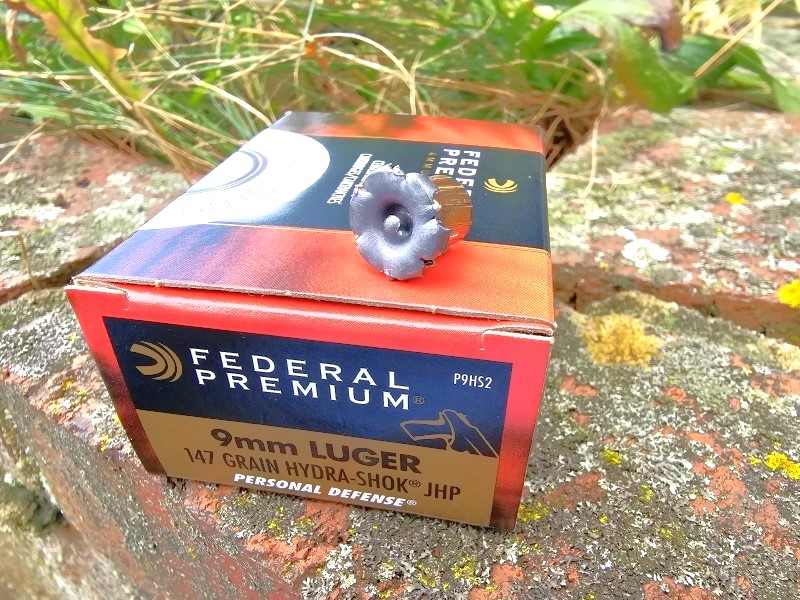
At one point, the US Secret Service used Hydra Shok in the 124-grain +P+ configuration. A friend of mine who worked in the Secret Service showed me his carry rounds in the early 1990s, so I can confirm that this is what they used. However, I’m not sure what they’re using now.
The ammo that I carry in some of my pistols is Hydra-Shok Tactical (HST) 124 Grain +P. These projectiles do not have a center post. The projectile’s jacket, however, is notched. The casings are nickel-plated, which seems to be the trend for high-end ammunition these days.
Hydra-Shok HST
As best I can gather, the HST version is the Hydra-Shok on steroids. It’s a bit faster and expands a little more reliably through a wider variety of mediums.
I carried the regular Hydra-Shok ammo when it first came out and have loved it ever since. In the past few years, I was able to get some HST, which also lives in some of my pistol magazines. I don’t think you can go wrong with either round.
Hydra-Shok and HST are also available in .45ACP, 10mm, .38 Special, 30 Super Carry, .357 Sig, .357 Magnum, and .380 ACP, among others.
Nosler ASP Defensive Ammo
ASP stands for Assured Stopping Power, and Nosler sure means it! I’ve come to realize that Nosler takes accuracy very seriously with their ammunition offerings, and this ammo is no exception.
I’ve tested a variety of pistol and rifle ammo from Nosler lately and have realized that their ammo is top-shelf—and clean! I hesitate to use this word with ammunition, but it’s so nicely put together that it’s “pretty.”
For this line, Nosler uses a skived bullet jacket designed to expand over a wide range of velocities. It’s also intended to penetrate deeply enough to stop bad people from doing nefarious things.
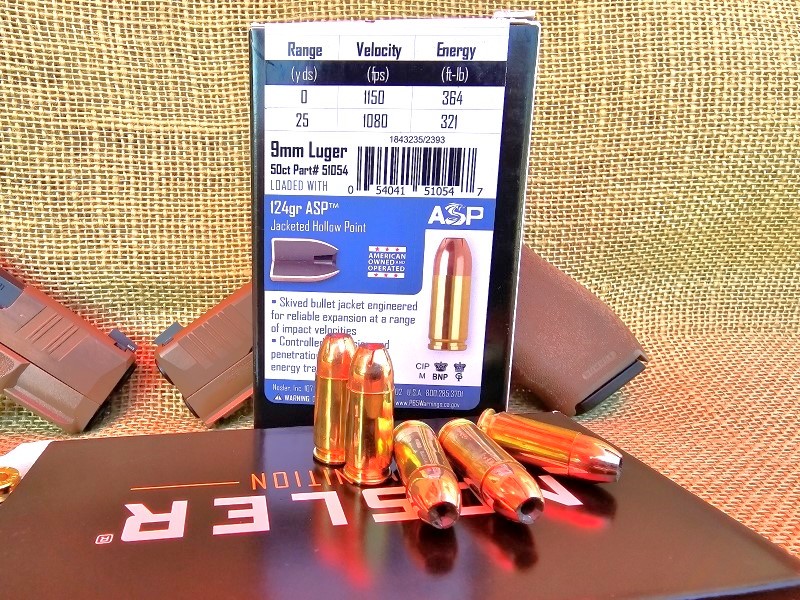
The mouth of this hollow point has an inward slope to facilitate smooth feeding in handguns, and it works well. So far, I’ve had no feeding issues with these rounds.
This ammo uses a pure lead core encased in a gilding metal of 95% copper and 5% zinc. The jacket is then deeply skived, so it will expand at velocities as low as 800 feet per second.
I tested the 124-grain 9mm loading, and I didn’t note any excessive recoil or muzzle flash at the range. I was able to land rapid hits on the targets, and reliability was 100%. Other calibers are also available in the ASP line: .45ACP, 10mm, and .40 Cal. S&W.
A pleasant bonus with this defensive handgun ammo is that, as of this writing, GunMag Warehouse has it for $15.99 per box of 20 rounds in 9mm. For a box of 50, it’s only $29.99, so it is priced less expensively than similar ammo from other brands.
Hornady American Gunner Ammo
Hornady’s American Gunner 124 grain +P XTP hollow point rounds come with 25 rounds to a box, as Hornady is fond of doing. When other manufacturers give you 20 rounds, Hornady throws in an extra five rounds, which is a neat little bonus. As this is written, this ammo sells for $19.99/box.

This is +P-rated ammo, so it will have a little more muzzle flip. Muzzle velocity is listed at 1,175 feet per second. Hornady always makes excellent ammunition, so these rounds can be trusted.
Not having access to ballistic gelatin myself, I did some research and checked out videos of these rounds going into gel through heavy clothing. Penetration was between 12 and 15 inches, which is outstanding for a hollow point.
This ammo checks off the boxes and is good to go. It is also available in other calibers.
Bottom Line
These are all great rounds. I’ve carried Hydra-Shok ammo in my handguns since its introduction in the late 1980s and have never been disappointed.
Speer’s Gold Dot is a stellar round, and a few of my handguns are stuffed with it. Its street track record is impeccable, which is why it’s used by so many law enforcement agencies worldwide.
I recently came upon the Nosler ASP 124-grain rounds, which also look very promising. I’ll be carrying some of them in my mags. I trust Nosler because all of their ammo is high-quality.
Nowadays, there is a ton of ammo to choose from. I’d feel fine carrying any of the rounds mentioned in this article, as I bet my life on them daily. Check them out; I think you’ll be well pleased with any of them.
Remember, the type of bullet you use comes in a distant second to shot placement. The only way to instantly stop a threat is with a shot to the Central Nervous System (CNS), which means the brain or spine. A hit outside of the CNS does not guarantee an instant stop, even if you hit the heart (a human can function for around 30 seconds after the heart stops, so be aware). Under the effects of adrenaline, a person might not even realize he’s been shot for some time.
I advise choosing quality defensive handgun ammo and practicing a lot at the range.


